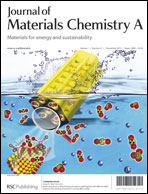A novel electrolyte with the ability to form a solid electrolyte interface on the anode and cathode of a LiMn2O4/graphite battery†
Abstract
To improve the cyclability of a LiMn2O4/graphite lithium ion battery at elevated temperature, a carbonate-based electrolyte using prop-1-ene-1,3-sultone (PES) as additive was developed. The cycling performance of the LiMn2O4/graphite cell, based on the developed electrolyte at 60 °C, was evaluated by a constant current charge/discharge test, with comparison of the electrolyte using vinylene carbonate (VC) as additive. It was found that the cell based on the developed electrolyte exhibits better cyclability and exhibits better dimensional stability at elevated temperatures. The capacity retention is 91% and the swell value in thickness is 3.4% for the cell with PES after 150 cycles at 60 °C, while the respective values were 68% and 36.4% for the cell without additive, and 82% and 9.1% for the cell with VC. The results obtained from scanning electron spectroscopy, X-ray photoelectron spectroscopy, X-ray diffraction, thermal gravimetric analysis, and molecular energy level calculations show that PES favors the formation of a stable solid electrolyte interphase, not only on the anode but also on the cathode of the LiMn2O4/graphite battery, effectively preventing electrolyte decomposition.


 Please wait while we load your content...
Please wait while we load your content...